Family Law Act in Australia: Reforms for Child and Family Protection
VerifiedAdded on 2022/10/01
|6
|1603
|275
Essay
AI Summary
This essay provides an in-depth analysis of the Family Law Act in Australia, emphasizing its critical role in child protection and family welfare. It explores the historical context of family law reform, highlighting the evolution from the Matrimonial Causes Act to the Family Law Act of 1975. The essay examines key reforms such as no-fault divorce, the establishment of family courts, and the shift towards prioritizing the well-being of children in custody disputes. It discusses how the Act addresses issues like marriage breakdown, domestic violence, and the changing roles of women in society. The importance of expert opinions from social workers and psychologists in court decisions is also highlighted. Furthermore, the essay concludes that the Family Law Act has significantly contributed to social changes and provided a robust legal framework for child care and family protection in Australia, adapting to the diverse needs of contemporary families.
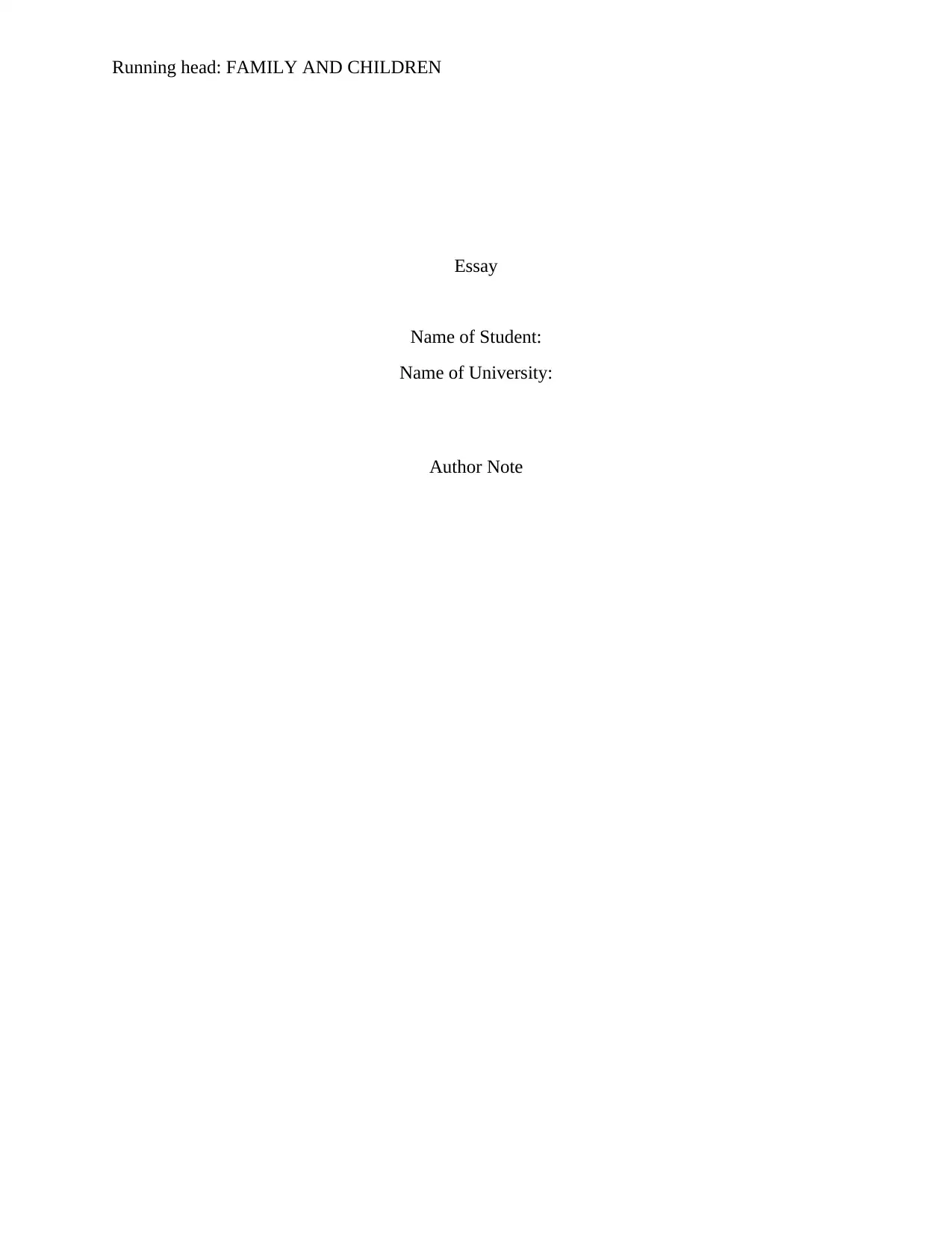
Running head: FAMILY AND CHILDREN
Essay
Name of Student:
Name of University:
Author Note
Essay
Name of Student:
Name of University:
Author Note
Paraphrase This Document
Need a fresh take? Get an instant paraphrase of this document with our AI Paraphraser
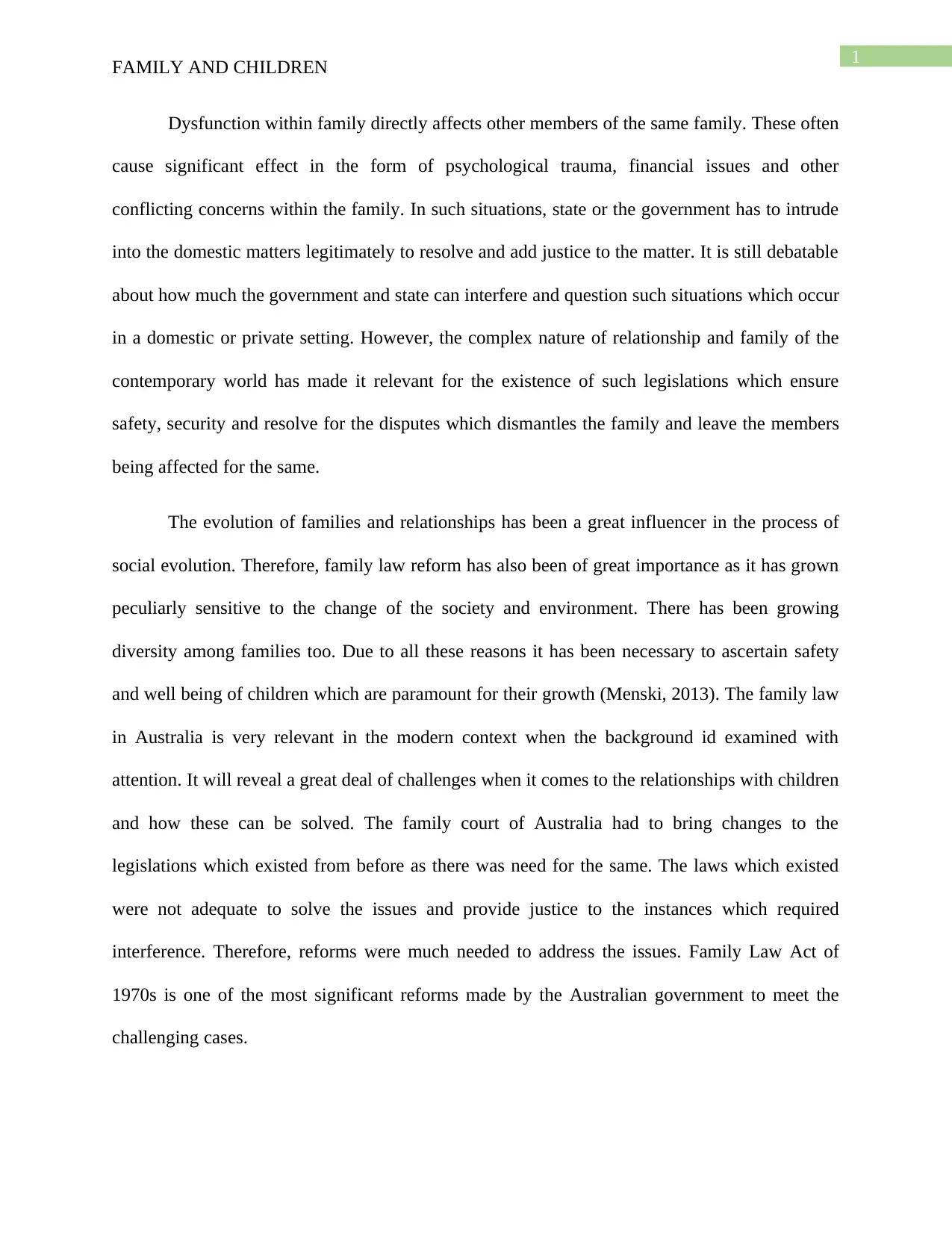
1
FAMILY AND CHILDREN
Dysfunction within family directly affects other members of the same family. These often
cause significant effect in the form of psychological trauma, financial issues and other
conflicting concerns within the family. In such situations, state or the government has to intrude
into the domestic matters legitimately to resolve and add justice to the matter. It is still debatable
about how much the government and state can interfere and question such situations which occur
in a domestic or private setting. However, the complex nature of relationship and family of the
contemporary world has made it relevant for the existence of such legislations which ensure
safety, security and resolve for the disputes which dismantles the family and leave the members
being affected for the same.
The evolution of families and relationships has been a great influencer in the process of
social evolution. Therefore, family law reform has also been of great importance as it has grown
peculiarly sensitive to the change of the society and environment. There has been growing
diversity among families too. Due to all these reasons it has been necessary to ascertain safety
and well being of children which are paramount for their growth (Menski, 2013). The family law
in Australia is very relevant in the modern context when the background id examined with
attention. It will reveal a great deal of challenges when it comes to the relationships with children
and how these can be solved. The family court of Australia had to bring changes to the
legislations which existed from before as there was need for the same. The laws which existed
were not adequate to solve the issues and provide justice to the instances which required
interference. Therefore, reforms were much needed to address the issues. Family Law Act of
1970s is one of the most significant reforms made by the Australian government to meet the
challenging cases.
FAMILY AND CHILDREN
Dysfunction within family directly affects other members of the same family. These often
cause significant effect in the form of psychological trauma, financial issues and other
conflicting concerns within the family. In such situations, state or the government has to intrude
into the domestic matters legitimately to resolve and add justice to the matter. It is still debatable
about how much the government and state can interfere and question such situations which occur
in a domestic or private setting. However, the complex nature of relationship and family of the
contemporary world has made it relevant for the existence of such legislations which ensure
safety, security and resolve for the disputes which dismantles the family and leave the members
being affected for the same.
The evolution of families and relationships has been a great influencer in the process of
social evolution. Therefore, family law reform has also been of great importance as it has grown
peculiarly sensitive to the change of the society and environment. There has been growing
diversity among families too. Due to all these reasons it has been necessary to ascertain safety
and well being of children which are paramount for their growth (Menski, 2013). The family law
in Australia is very relevant in the modern context when the background id examined with
attention. It will reveal a great deal of challenges when it comes to the relationships with children
and how these can be solved. The family court of Australia had to bring changes to the
legislations which existed from before as there was need for the same. The laws which existed
were not adequate to solve the issues and provide justice to the instances which required
interference. Therefore, reforms were much needed to address the issues. Family Law Act of
1970s is one of the most significant reforms made by the Australian government to meet the
challenging cases.
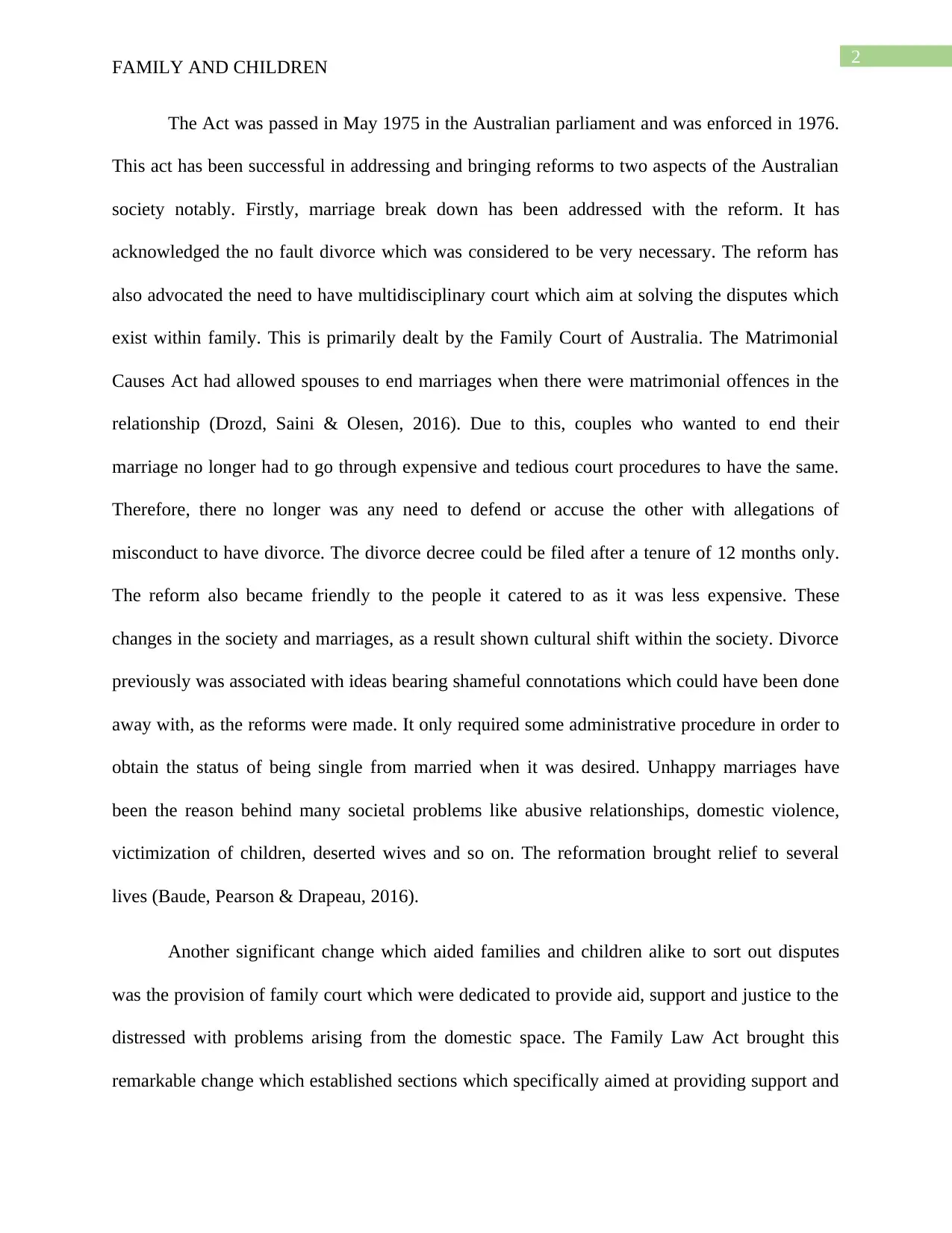
2
FAMILY AND CHILDREN
The Act was passed in May 1975 in the Australian parliament and was enforced in 1976.
This act has been successful in addressing and bringing reforms to two aspects of the Australian
society notably. Firstly, marriage break down has been addressed with the reform. It has
acknowledged the no fault divorce which was considered to be very necessary. The reform has
also advocated the need to have multidisciplinary court which aim at solving the disputes which
exist within family. This is primarily dealt by the Family Court of Australia. The Matrimonial
Causes Act had allowed spouses to end marriages when there were matrimonial offences in the
relationship (Drozd, Saini & Olesen, 2016). Due to this, couples who wanted to end their
marriage no longer had to go through expensive and tedious court procedures to have the same.
Therefore, there no longer was any need to defend or accuse the other with allegations of
misconduct to have divorce. The divorce decree could be filed after a tenure of 12 months only.
The reform also became friendly to the people it catered to as it was less expensive. These
changes in the society and marriages, as a result shown cultural shift within the society. Divorce
previously was associated with ideas bearing shameful connotations which could have been done
away with, as the reforms were made. It only required some administrative procedure in order to
obtain the status of being single from married when it was desired. Unhappy marriages have
been the reason behind many societal problems like abusive relationships, domestic violence,
victimization of children, deserted wives and so on. The reformation brought relief to several
lives (Baude, Pearson & Drapeau, 2016).
Another significant change which aided families and children alike to sort out disputes
was the provision of family court which were dedicated to provide aid, support and justice to the
distressed with problems arising from the domestic space. The Family Law Act brought this
remarkable change which established sections which specifically aimed at providing support and
FAMILY AND CHILDREN
The Act was passed in May 1975 in the Australian parliament and was enforced in 1976.
This act has been successful in addressing and bringing reforms to two aspects of the Australian
society notably. Firstly, marriage break down has been addressed with the reform. It has
acknowledged the no fault divorce which was considered to be very necessary. The reform has
also advocated the need to have multidisciplinary court which aim at solving the disputes which
exist within family. This is primarily dealt by the Family Court of Australia. The Matrimonial
Causes Act had allowed spouses to end marriages when there were matrimonial offences in the
relationship (Drozd, Saini & Olesen, 2016). Due to this, couples who wanted to end their
marriage no longer had to go through expensive and tedious court procedures to have the same.
Therefore, there no longer was any need to defend or accuse the other with allegations of
misconduct to have divorce. The divorce decree could be filed after a tenure of 12 months only.
The reform also became friendly to the people it catered to as it was less expensive. These
changes in the society and marriages, as a result shown cultural shift within the society. Divorce
previously was associated with ideas bearing shameful connotations which could have been done
away with, as the reforms were made. It only required some administrative procedure in order to
obtain the status of being single from married when it was desired. Unhappy marriages have
been the reason behind many societal problems like abusive relationships, domestic violence,
victimization of children, deserted wives and so on. The reformation brought relief to several
lives (Baude, Pearson & Drapeau, 2016).
Another significant change which aided families and children alike to sort out disputes
was the provision of family court which were dedicated to provide aid, support and justice to the
distressed with problems arising from the domestic space. The Family Law Act brought this
remarkable change which established sections which specifically aimed at providing support and
⊘ This is a preview!⊘
Do you want full access?
Subscribe today to unlock all pages.

Trusted by 1+ million students worldwide
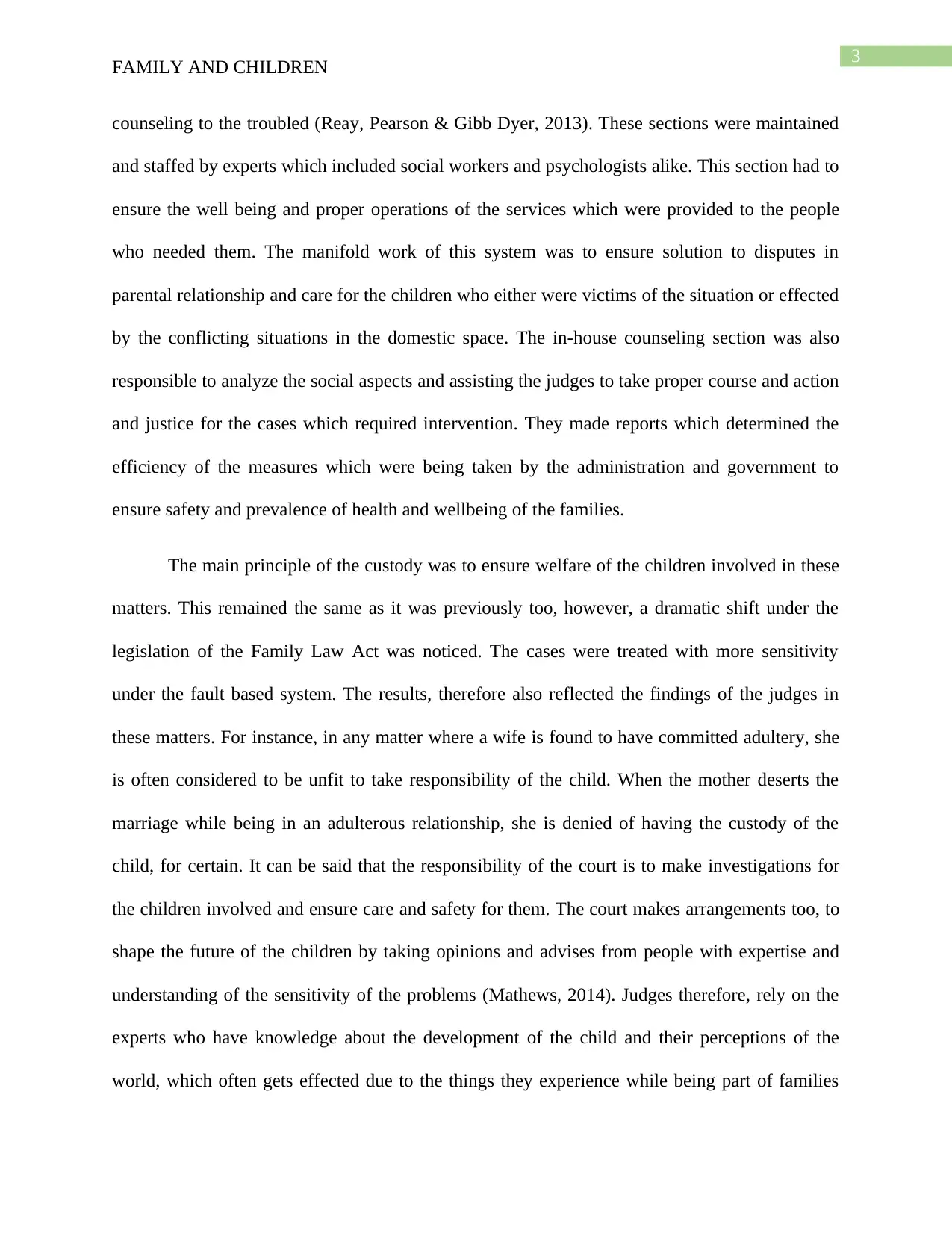
3
FAMILY AND CHILDREN
counseling to the troubled (Reay, Pearson & Gibb Dyer, 2013). These sections were maintained
and staffed by experts which included social workers and psychologists alike. This section had to
ensure the well being and proper operations of the services which were provided to the people
who needed them. The manifold work of this system was to ensure solution to disputes in
parental relationship and care for the children who either were victims of the situation or effected
by the conflicting situations in the domestic space. The in-house counseling section was also
responsible to analyze the social aspects and assisting the judges to take proper course and action
and justice for the cases which required intervention. They made reports which determined the
efficiency of the measures which were being taken by the administration and government to
ensure safety and prevalence of health and wellbeing of the families.
The main principle of the custody was to ensure welfare of the children involved in these
matters. This remained the same as it was previously too, however, a dramatic shift under the
legislation of the Family Law Act was noticed. The cases were treated with more sensitivity
under the fault based system. The results, therefore also reflected the findings of the judges in
these matters. For instance, in any matter where a wife is found to have committed adultery, she
is often considered to be unfit to take responsibility of the child. When the mother deserts the
marriage while being in an adulterous relationship, she is denied of having the custody of the
child, for certain. It can be said that the responsibility of the court is to make investigations for
the children involved and ensure care and safety for them. The court makes arrangements too, to
shape the future of the children by taking opinions and advises from people with expertise and
understanding of the sensitivity of the problems (Mathews, 2014). Judges therefore, rely on the
experts who have knowledge about the development of the child and their perceptions of the
world, which often gets effected due to the things they experience while being part of families
FAMILY AND CHILDREN
counseling to the troubled (Reay, Pearson & Gibb Dyer, 2013). These sections were maintained
and staffed by experts which included social workers and psychologists alike. This section had to
ensure the well being and proper operations of the services which were provided to the people
who needed them. The manifold work of this system was to ensure solution to disputes in
parental relationship and care for the children who either were victims of the situation or effected
by the conflicting situations in the domestic space. The in-house counseling section was also
responsible to analyze the social aspects and assisting the judges to take proper course and action
and justice for the cases which required intervention. They made reports which determined the
efficiency of the measures which were being taken by the administration and government to
ensure safety and prevalence of health and wellbeing of the families.
The main principle of the custody was to ensure welfare of the children involved in these
matters. This remained the same as it was previously too, however, a dramatic shift under the
legislation of the Family Law Act was noticed. The cases were treated with more sensitivity
under the fault based system. The results, therefore also reflected the findings of the judges in
these matters. For instance, in any matter where a wife is found to have committed adultery, she
is often considered to be unfit to take responsibility of the child. When the mother deserts the
marriage while being in an adulterous relationship, she is denied of having the custody of the
child, for certain. It can be said that the responsibility of the court is to make investigations for
the children involved and ensure care and safety for them. The court makes arrangements too, to
shape the future of the children by taking opinions and advises from people with expertise and
understanding of the sensitivity of the problems (Mathews, 2014). Judges therefore, rely on the
experts who have knowledge about the development of the child and their perceptions of the
world, which often gets effected due to the things they experience while being part of families
Paraphrase This Document
Need a fresh take? Get an instant paraphrase of this document with our AI Paraphraser
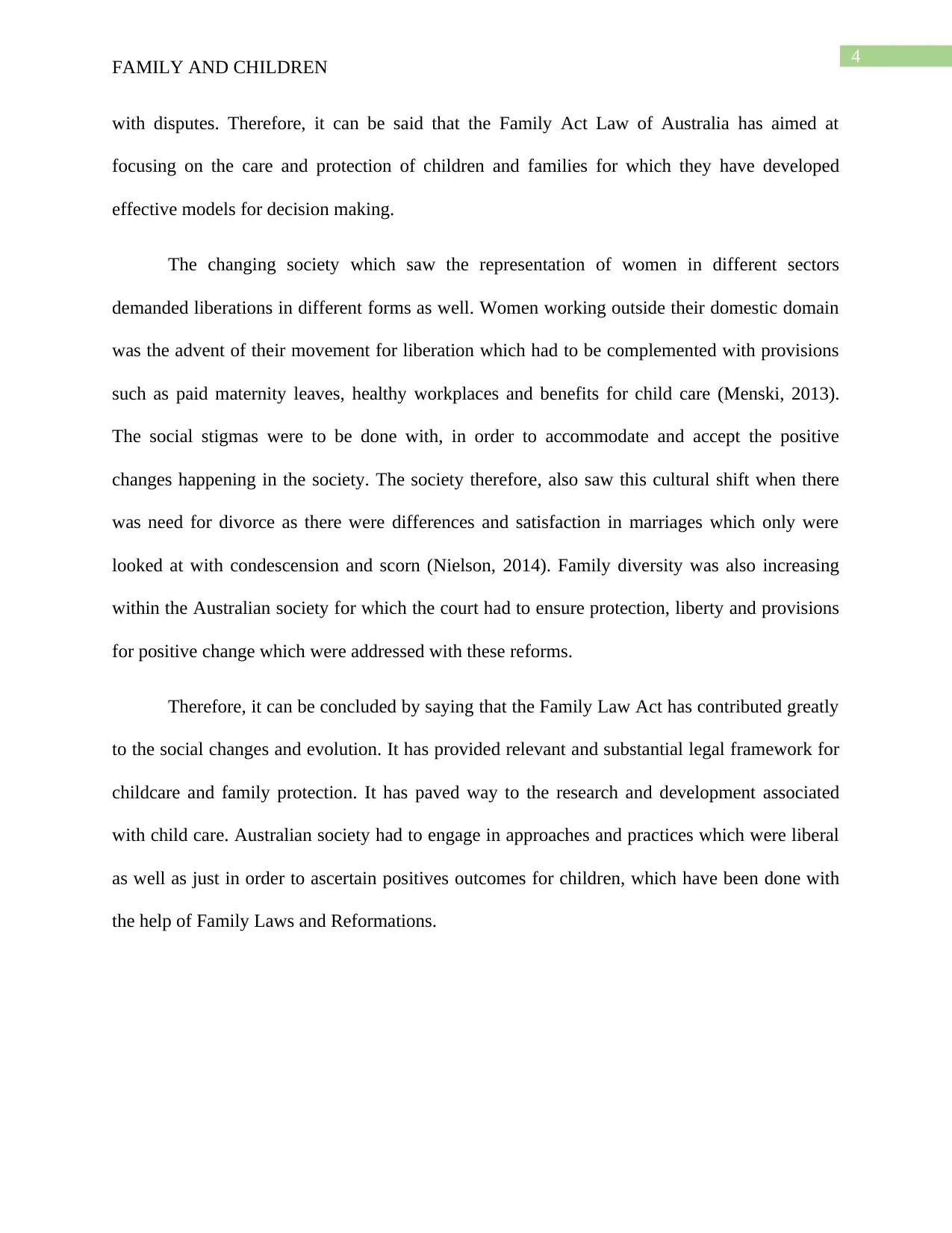
4
FAMILY AND CHILDREN
with disputes. Therefore, it can be said that the Family Act Law of Australia has aimed at
focusing on the care and protection of children and families for which they have developed
effective models for decision making.
The changing society which saw the representation of women in different sectors
demanded liberations in different forms as well. Women working outside their domestic domain
was the advent of their movement for liberation which had to be complemented with provisions
such as paid maternity leaves, healthy workplaces and benefits for child care (Menski, 2013).
The social stigmas were to be done with, in order to accommodate and accept the positive
changes happening in the society. The society therefore, also saw this cultural shift when there
was need for divorce as there were differences and satisfaction in marriages which only were
looked at with condescension and scorn (Nielson, 2014). Family diversity was also increasing
within the Australian society for which the court had to ensure protection, liberty and provisions
for positive change which were addressed with these reforms.
Therefore, it can be concluded by saying that the Family Law Act has contributed greatly
to the social changes and evolution. It has provided relevant and substantial legal framework for
childcare and family protection. It has paved way to the research and development associated
with child care. Australian society had to engage in approaches and practices which were liberal
as well as just in order to ascertain positives outcomes for children, which have been done with
the help of Family Laws and Reformations.
FAMILY AND CHILDREN
with disputes. Therefore, it can be said that the Family Act Law of Australia has aimed at
focusing on the care and protection of children and families for which they have developed
effective models for decision making.
The changing society which saw the representation of women in different sectors
demanded liberations in different forms as well. Women working outside their domestic domain
was the advent of their movement for liberation which had to be complemented with provisions
such as paid maternity leaves, healthy workplaces and benefits for child care (Menski, 2013).
The social stigmas were to be done with, in order to accommodate and accept the positive
changes happening in the society. The society therefore, also saw this cultural shift when there
was need for divorce as there were differences and satisfaction in marriages which only were
looked at with condescension and scorn (Nielson, 2014). Family diversity was also increasing
within the Australian society for which the court had to ensure protection, liberty and provisions
for positive change which were addressed with these reforms.
Therefore, it can be concluded by saying that the Family Law Act has contributed greatly
to the social changes and evolution. It has provided relevant and substantial legal framework for
childcare and family protection. It has paved way to the research and development associated
with child care. Australian society had to engage in approaches and practices which were liberal
as well as just in order to ascertain positives outcomes for children, which have been done with
the help of Family Laws and Reformations.
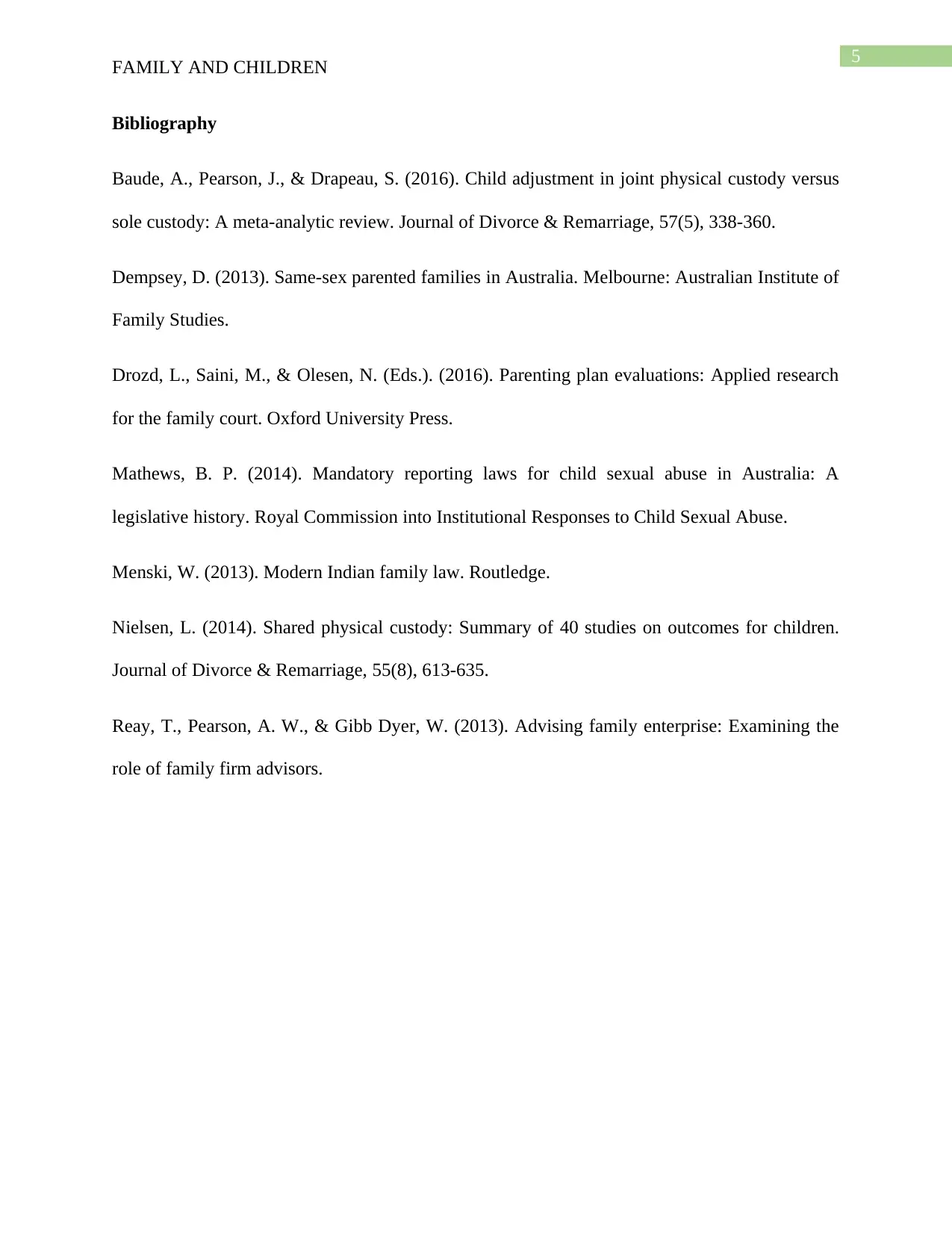
5
FAMILY AND CHILDREN
Bibliography
Baude, A., Pearson, J., & Drapeau, S. (2016). Child adjustment in joint physical custody versus
sole custody: A meta-analytic review. Journal of Divorce & Remarriage, 57(5), 338-360.
Dempsey, D. (2013). Same-sex parented families in Australia. Melbourne: Australian Institute of
Family Studies.
Drozd, L., Saini, M., & Olesen, N. (Eds.). (2016). Parenting plan evaluations: Applied research
for the family court. Oxford University Press.
Mathews, B. P. (2014). Mandatory reporting laws for child sexual abuse in Australia: A
legislative history. Royal Commission into Institutional Responses to Child Sexual Abuse.
Menski, W. (2013). Modern Indian family law. Routledge.
Nielsen, L. (2014). Shared physical custody: Summary of 40 studies on outcomes for children.
Journal of Divorce & Remarriage, 55(8), 613-635.
Reay, T., Pearson, A. W., & Gibb Dyer, W. (2013). Advising family enterprise: Examining the
role of family firm advisors.
FAMILY AND CHILDREN
Bibliography
Baude, A., Pearson, J., & Drapeau, S. (2016). Child adjustment in joint physical custody versus
sole custody: A meta-analytic review. Journal of Divorce & Remarriage, 57(5), 338-360.
Dempsey, D. (2013). Same-sex parented families in Australia. Melbourne: Australian Institute of
Family Studies.
Drozd, L., Saini, M., & Olesen, N. (Eds.). (2016). Parenting plan evaluations: Applied research
for the family court. Oxford University Press.
Mathews, B. P. (2014). Mandatory reporting laws for child sexual abuse in Australia: A
legislative history. Royal Commission into Institutional Responses to Child Sexual Abuse.
Menski, W. (2013). Modern Indian family law. Routledge.
Nielsen, L. (2014). Shared physical custody: Summary of 40 studies on outcomes for children.
Journal of Divorce & Remarriage, 55(8), 613-635.
Reay, T., Pearson, A. W., & Gibb Dyer, W. (2013). Advising family enterprise: Examining the
role of family firm advisors.
⊘ This is a preview!⊘
Do you want full access?
Subscribe today to unlock all pages.

Trusted by 1+ million students worldwide
1 out of 6
Related Documents
Your All-in-One AI-Powered Toolkit for Academic Success.
+13062052269
info@desklib.com
Available 24*7 on WhatsApp / Email
![[object Object]](/_next/static/media/star-bottom.7253800d.svg)
Unlock your academic potential
Copyright © 2020–2025 A2Z Services. All Rights Reserved. Developed and managed by ZUCOL.





